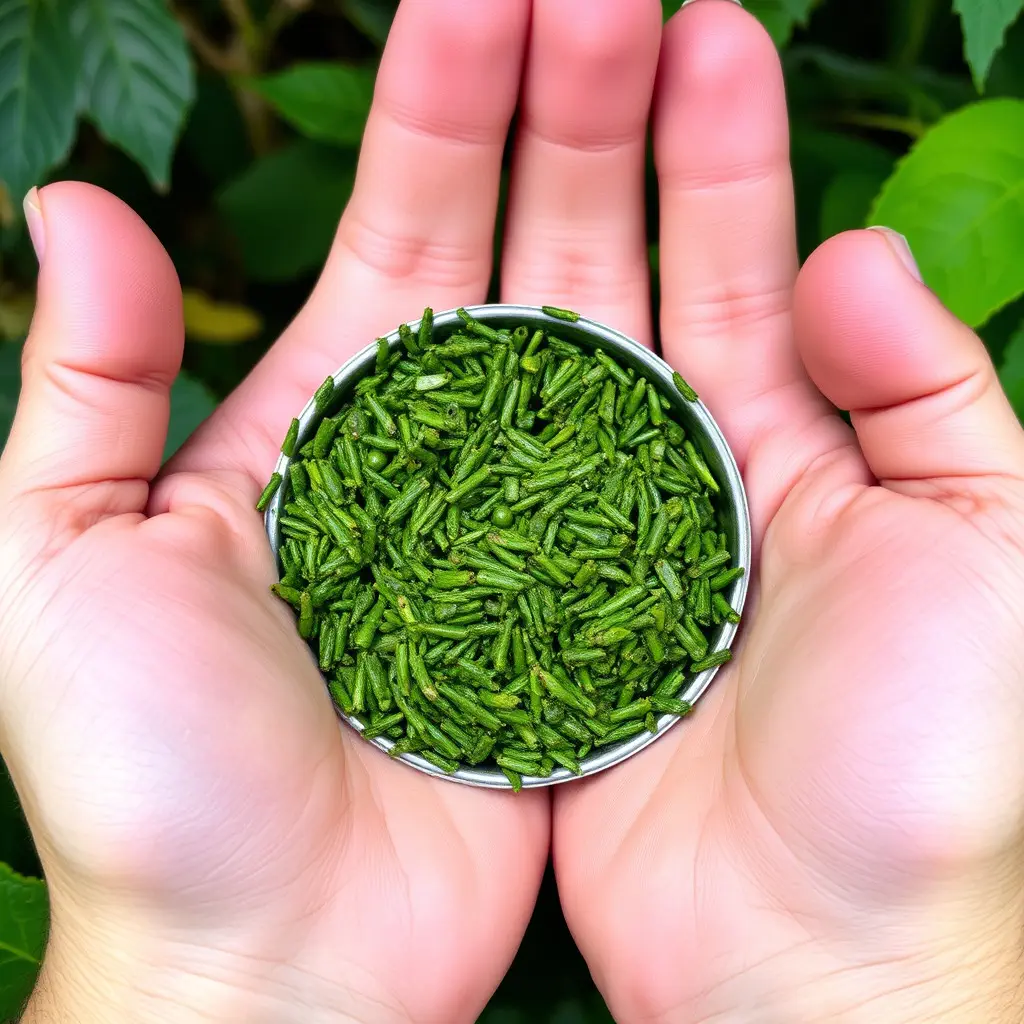Kratom, derived from Southeast Asia's Mitragyna speciosa, has gained attention as a natural alternative for managing chronic pain. Its active compounds, mitragynine and 7-hydroxymitragynine, provide analgesic effects by interacting with opioid receptors in the brain, potentially offering relief without the high addiction risks of traditional opioids. Ongoing research is assessing kratom's efficacy and safety for pain management, suggesting it could be a complementary component within a multifaceted treatment plan. The effects of kratom vary with dosage, ranging from stimulant to opioid-like, emphasizing the need for caution and personalized approach. Users should consult medical professionals before using kratom, as its benefits and potential risks are still under investigation. Kratom's adaptogenic properties also indicate its potential role in stress management and maintaining bodily equilibrium, alongside promoting mood enhancement through the release of dopamine and serotonin. As a holistic approach to chronic pain, integrating kratom with exercise, diet, and other therapeutic methods can lead to an improved quality of life. It is essential for individuals to use kratom responsibly, ensuring safe dosing and monitoring for any adverse effects, to fully harness its potential in supporting resilience against chronic pain.
Exploring the multifaceted relationship between kratom and chronic pain management, this article delves into the ways in which kratom can support overall well-being and resilience. From its analgesic properties to its potential role in building mental fortitude, “Kratom and Chronic Pain Management: A Pathway to Well-being and Resilience” unravels the science behind its effects and guides readers through responsible use for sustainable health benefits. Join us as we navigate the nuanced landscape of kratom’s therapeutic potential in managing chronic pain.
- Unraveling the Role of Kratom in Chronic Pain Management: An Overview
- The Science Behind Kratom's Analgesic Effects and Well-being Promotion
- Navigating Kratom Use for Resilience Building and Chronic Pain Relief
Unraveling the Role of Kratom in Chronic Pain Management: An Overview

Kratom, a plant from Southeast Asia with leaves that contain compounds that can have psychological effects, has garnered attention for its potential role in chronic pain management. Users typically consume kratom either by chewing the leaves or by brewing them into a tea, encapsulating them, or smoking them. The alkaloids present in kratom, principally mitragynine and 7-hydroxymitragynine, are thought to interact with the opioid receptors in the brain, which can provide pain relief for individuals suffering from chronic conditions. This interaction may help manage chronic pain more effectively, offering a potential alternative to traditional opioids that come with significant risks of addiction and misuse.
Research into kratom’s efficacy and safety profile in chronic pain management is ongoing, with some studies suggesting it could be a beneficial addition to a comprehensive pain treatment plan. However, due to the varying strains of kratom and individual differences in metabolism and sensitivity, its use must be approached with caution. The impact of kratom can range from stimulant-like effects at lower doses to opioid-like effects at higher doses, which underscores the need for further research to fully understand its potential benefits and risks. Users considering kratom as a component of their pain management strategy should consult healthcare professionals to ensure safe and effective use in conjunction with other therapeutic interventions.
The Science Behind Kratom's Analgesic Effects and Well-being Promotion

Kratom, a plant native to Southeast Asia, has garnered attention in various circles for its potential therapeutic properties, particularly in the realm of pain management and the promotion of well-being. The effects of kratom are attributed to its alkaloid content, primarily mitragynine and 7-hydroxymitragynine, which interact with the body’s opioid receptors. These interactions are believed to underpin kratom’s analgesic effects, offering relief for individuals suffering from chronic pain conditions. Scientific studies have shown that kratom can modulate pain signals in the brain, effectively reducing the sensation of pain without the side effects commonly associated with opioid medications.
Beyond its analgesic properties, kratom is also being explored for its potential to enhance well-being and resilience. The alkaloids within kratom may stimulate the release of neurotransmitters such as dopamine and serotonin, which are associated with feelings of happiness and contentment. This neurochemical influence could contribute to a more positive mood and a sense of tranquility. Additionally, the adaptogenic qualities of kratom suggest it may help the body manage stress and promote a state of balance or homeostasis. Users report that kratom helps them cope with both physical and emotional discomfort, thereby supporting overall well-being and resilience in the face of life’s challenges. As research continues to unfold, the role of kratom in natural pain management and holistic health remains an area of significant interest and ongoing exploration.
Navigating Kratom Use for Resilience Building and Chronic Pain Relief

Mitigating chronic pain through natural interventions can significantly enhance an individual’s resilience, allowing them to better manage the challenges associated with persistent discomfort. Kratom, a botanical derived from the leaves of Mitragyna speciosa, has garnered attention in the realm of pain management due to its potential analgesic properties. For those grappling with chronic pain, incorporating kratom into their wellness regimen may offer notable relief, contributing to an improved quality of life and increased resilience. It’s crucial for individuals considering kratom to consult with healthcare professionals to navigate its use responsibly, ensuring appropriate dosing and monitoring for side effects. Additionally, kratom should be part of a comprehensive pain management strategy that includes other healthy practices and therapies, such as physical exercise, proper nutrition, and stress-reduction techniques, all of which can bolster resilience and promote overall well-being. The key to effectively using kratom for pain relief lies in its careful integration with these holistic approaches, fostering a more balanced and adaptive response to chronic pain conditions. Proper education on the correct strain selection and understanding of the nuanced effects of different kratom varieties can empower individuals to harness its benefits while minimizing potential risks. This thoughtful approach to kratom use can be instrumental in supporting resilience, enabling patients to face their daily challenges with greater fortitude and ease.
Kratom’s potential as a component of chronic pain management, grounded in its analgesic effects and positive impact on overall well-being and resilience, presents a promising area for further research and consideration. The insights gleaned from the reviewed literature underscore the importance of a nuanced approach to integrating kratom into therapeutic practices, balancing its benefits with prudent use guidelines. As evidenced by the scientific data, kratom may offer significant relief for those grappling with persistent pain and contribute to fostering resilience. Future studies are essential to elucidate optimal dosing, long-term effects, and its role in multidisciplinary treatment plans. With careful scrutiny and responsible application, kratom could be a valuable tool in the arsenal against chronic pain and in enhancing the quality of life for many individuals.






